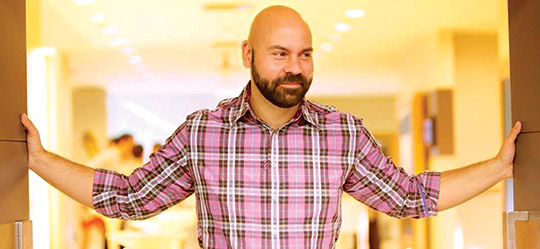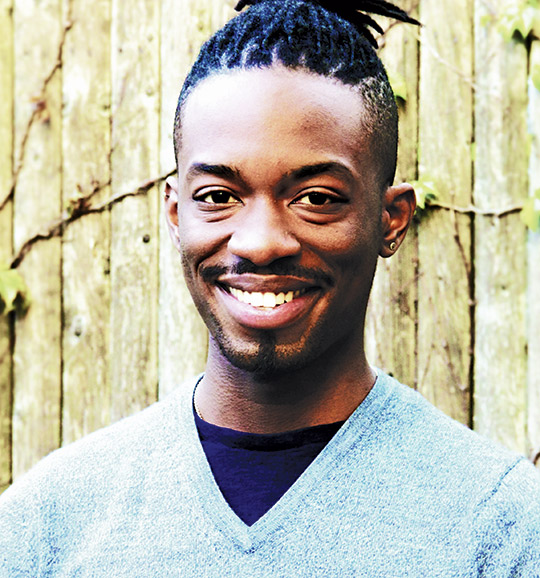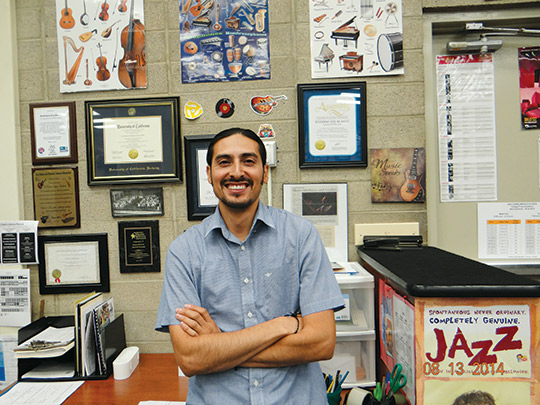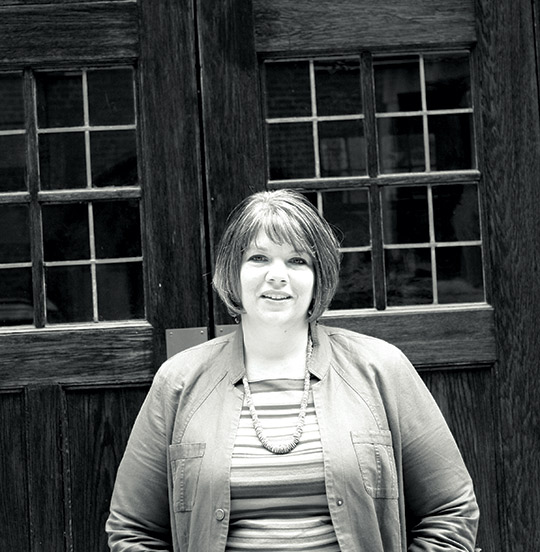Early Risers
By: Jonathan Sapers
A different kind of screening: A Serbian immigrant journeys from health education to Hollywood
Srdjan Stakic Ed.D’05
How does a Serbian immigrant trained in health and human rights education end up
making award-winning feature films for YouTube? The answer is itself pure Hollywood, beginning in war-torn Serbia with a frightened 16-year-old’s revulsion at Serbian television propaganda and culminating back there 21 years later with his Los Angeles¬ based production company wrapping its first film.
“I remember watching the news and getting really angry because they were saying, ‘The Muslims and Croatians are doing these terrible things to the Serbs,’” recalls Srdjan Stakic.
“And it probably was true but not nearly to the extent that Serbians were doing terrible things to them. Yet for a split second I was buying into the propaganda.” He wanted desperately to get out, but the foreign embassies in Belgrade all turned him away. Then, out of the blue, came a call from an American family in Yakima, Washington.
They had seen a story in the town paper about a Yugoslavian girl who was staying with another local family. “And she gave them my name,” Stakic says, still marveling. “It’s craziness. Her parents knew my parents. And they said, ‘Do you want to come to the States?” Two years later, he brought his family to live with distant relatives in Michigan. Both his parents were psychologists, but in the United States his father worked in a restaurant kitchen and his mother at a Dunkin’ Donuts.
Stakic himself waited tables while studying biopsychology and cognitive science at the University of Michigan. Then it was on to TC and a doctorate in health education. “I knew I wanted to end up giving back,” he says. “And I’m gay, so the psychology of sexuality and HIV prevention became the subject I was involved with.”
At TC, Stakic created an international health website for the United Nations. When he queried young people around the world about how to make the program “cool,” the near-unanimous answer was MTV, so he became a de facto producer.
He enrolled in the University of Southern California’s producing program, interned on the Universal Studios lot, got hired as a translator for an Angelina Jolie movie set in Bosnia (In the Land of Blood and Honey) and, with Fast and Furious franchise director Justin Lin, wound up as a co-executive, producing a screen adaptation of Yellow Face, the Pulitzer-finalist play by David Henry Hwang (M. Butterfly, Aida) about anti-Asian prejudice in entertainment.
The film took top honors at the L.A. Asian-Pacific Film Festival and became the first feature movie produced for YouTube. Stakic has enjoyed his celebrity but is happiest that his parents are now university professors in the United States and his sister has earned her Ph.D. “The story of my success is the story of my family’s success,” he says. “That’s what I’m most proud of.
Drawing Kids Into Learning: Comic Books in Nigeria affirm the power of personal experience
Michael Bitz--Ed.D’98
Michael Bitz (ED.D. ’98) has become an education rock star for the Comic Book Project, which hooks young people on reading and writing through the creation of graphic novels. So last year, 20 minutes into a United Nations- and Ford Foundation-funded tour of Nigeria, he was startled to discover that his audience of teachers and librarians had, for the most part, never seen a comic book.
No matter. The Nigerians were soon demonstrating their grasp of the medium’s potential for dealing with darker subjects. “Many of their comics were about Boko Haram,” Bitz says, referring to the militant group infamous for its mass kidnapping of Nigerian schoolgirls.
“It reaffirmed for me that personal experience is always part of the learning environment and that we should capitalize on it rather than pushing it under the table.”
Disillusioned by a stint in educational publishing, Bitz enrolled at TC in 1994 in search of a new way to promote learning through the arts. After experimenting with music, he hit on “engaging children in the process of planning, writing, designing and publishing original comic books.”
“Now half the Scholastic catalogue is graphic novels,” he says. He piloted the Comic Book Project in a New York City middle school in 2001 and then went national. Early funders ranged from the Environmental Protection Agency in New York City to the Cleveland Foundation, which focused on conflict resolution.
Current partners include the Brooklyn Public Library and the New York City Housing Authority. Meanwhile, Bitz has launched the Youth Music Exchange, through which kids write record and market music for record labels they establish in their schools.
“When it comes to education, I think we all agree that the endgame is the same. It’s just how we get there that’s different,” says Bitz, who also teaches at Ramapo College of New Jersey. “And that’s what curriculum ought to be- people taking ideas and forming them for their own purposes.
Meeting Her Audience Halfway : Teaching Skills for success in an over-saturated market
Emily Ondracek--Ed.D’13
Being a performer is wonderful but it’s very one-sided,” says violinist Emily Ondracek. “There’s a disconnect with the audience.”
Ondracek has bridged that gap onstage and in the classroom, writing a 500-page thesis that included interviews with other classical musicians about what they’d learned since leaving the conservatory.
“I was asking how they define success, both in the conservatory and now,” she says. “What skills have they had to learn as professionals?”
Ondracek, who debuted at 16 with the Chicago Symphony Orchestra and attended Juilliard, says she’s learned “a lot about networking — about developing relationships with presenters, about the kinds of information you need to have on websites, about niches that differentiate you from other violinists. You have to be aware of the world around you.
What is society looking for? Because there is an over-saturation of really fine musicians on the market. Very few traditional orchestra positions are available now that can support a person, so we’ve had to become more creative about making a living.”
With her husband, violist Erik Peterson, Ondracek launched Hire Conservatory Alumni, a business that helps Juilliard- and other conservatory-trained graduates get gigs at private events.
With violinist Galina Zhdanova and cellist Adrian Daurov, Ondracek and Peterson formed the Voxare String Quartet, since hailed by the Pulitzer prize-winning composer Ned Rorem as “probably the best American chamber group performing today.” Besides a full classical music repertoire, Voxare plays Radiohead and even the Rolling Stones. The group, which performed for TC’s 125th anniversary Gala in November 2013, will soon produce an album, appropriately called Mixtape.
Ondracek, who teaches at TC and in New York City schools as a New York Philharmonic Teaching Artist and was just named Chair of the string department at Metropolitan State University in Denver, is resolutely old-fashioned about practicing. “The end results are what the world sees,” she writes on her website. “The student will only get in return what she puts into the task.”
Dancing in FootStep of Giants: Channeling TC history to get kids moving
By Aston M. McCullough – Doctoral Student
Every day the toddlers in SKIP of New York, a movement program employed at an Early Head Start center in New York City, channel John Dewey, Maxine Greene and current TC faculty.
Why such a powerful intellectual canon behind an exercise program? “It appears that an overwhelming number of kids in this country are sedentary, particularly in families who don’t have access to physical activity resources. Their parents are largely leading sedentary lifestyles, too,” says the program’s co-designer, TC doctoral student Aston K. McCullough.
Equally disturbing, he says, sedentary toddlers may also miss out on developing basic movement skills used in play, learning and engaging with others. McCullough has danced since childhood and taught abroad and in the United States.
He earned his liberal arts B.A. at Sarah Lawrence College (an institution with close philosophical ties to Dewey), his master’s degree in dance education from New York University (he wrote his thesis on Greene’s theory of aesthetic education, empathy and imagination as applied to dance teaching) and his Professional Diploma in Dance Studies from Trinity Laban Conservatoire of Music and Dance in London. But two years ago, he needed tools to answer new questions.
Could a well-designed movement program not only improve kids’ conditioning but also support other aspects of wellness? How might dance, which instantly translates across cultures, be used to increase physical activity in various urban contexts? So McCullough came to TC, where he studied with Greene before her death last spring.
As a TC Zankel Fellow, he spent two years at an Early Head Start center, focusing on the physical activity of two- and three-year-olds, alone and with their parents. Supervised by Carol Ewing Garber, Associate Professor of Movement Science and President of the American College of Sports Medicine, McCullough, with fellow master’s student Christine Salgado, blueprinted SKIP. Now McCullough, Garber and Helena Duch of Columbia’s Mailman School of Public Health are conducting a pilot study of SKIP in an Early Head Start program.
McCullough, who initially enrolled as an advanced master’s degree student, has been invited to earn his doctorate at TC, where he hopes to apply what he is learning with SKIP to develop physical activity programs for children recovering from cancer and in other special circumstances.
McCullough is excited about it all, especially the guest lectures he delivered, at Greene’s request, on dance aesthetics, imagination and “the everyday.” “I am very grateful,” he says. “Each conversation with Maxine was a formative experience.
Winning Plaudits for the Baton
Eufemio Escalante – M.A ’06
Eufemio Escalante’s parents grew up in a remote town in central western Mexico, where everyone shared the few musical instruments. Today, Escalante brings the same mindset to Vina Danks Middle School in Ontario, California. His students, who recently nominated him for a GRAMMY Music Educator Award, learn that music is not theirs but something to pass along. When they bow, they pay tribute to family and friends. “Once I teach a leader in a section, he or she becomes a role model,” Escalante says. “The kids feel empowered.”
As a fourth grader, Escalante nagged his father, a self-taught guitarist, for a trumpet after mariachi players visited school. “He saved for it. Then he said, ‘You’re going to practice; you’re going to play.’” Escalante complied until he went to culinary school and became the chef’s assistant in the restaurant at Sony Pictures.
He quit to attend community college, where a faculty member, Steve Wilkerson, approached him. “I was looking at a music poster and he says, ‘Son, would you like to be in jazz?’ Escalante took classes in improvisation and theory and later earned a music degree at University of California, Berkeley.
Then a friend’s uncle, Luis Fregoso, invited him to help teach mariachi in the local schools. “He said, ‘You should do this for a living.” So Escalante came to TC and taught in public schools and absorbed the music scene. At Vina Danks, he expanded the band and orchestra and asked Fregoso to help form a mariachi group. One day a student asked Escalante his dreams.
“I said, ‘I’d love to win a GRAMMY,’ and another kid says, ‘Open your email, Mr. E.’” Escalante, one of 222 GRAMMY quarter-finalists, grins. “Now I can say, ‘Hey kids, I made a dream come true. What’s your dream?”
Lifting the Veil
Amanda Newman – Godfrey Doctoral Student M.A. ‘ 99
When she was 17, Amanda Newman-Godfrey’s leg was crushed while she loaded her horse into a trailer. She was left with a permanent disability and a feeling of “being other.” “The art studio became my respite,” she recalls.
In 1995, after finishing college and starting a business in equine photography and fine art landscape, Newman-Godfrey taught art to students with special needs in central New Jersey. “I understood what it was like to use art materials to express ideas,” she says. She stayed 11 years and oversaw five departments, along the way earning her master’s in Art and Education at TC as well as teaching certification.
Subsequently Newman-Godfrey managed the long-term Artist-in-Education Residency Grant Program of Young Audiences NJ and the New Jersey State Council on the Arts. She became a TC doctoral student in 2009 and this spring will defend her dissertation on how art-making and discussions of art affect the development of adolescents with autism.
“In the art room, the veils of autism can lift, and children come out of their shells a bit,” she says. Now Assistant Professor of Art Education at Philadelphia’s all-female Moore College of Art and Design, Newman-Godfrey combines her interest in children with special needs with teaching art teachers.
“So many incredible special educators and art educators see a connection between the two fields,” she says. “We must support that vision.”
Published Friday, Jan. 23, 2015





